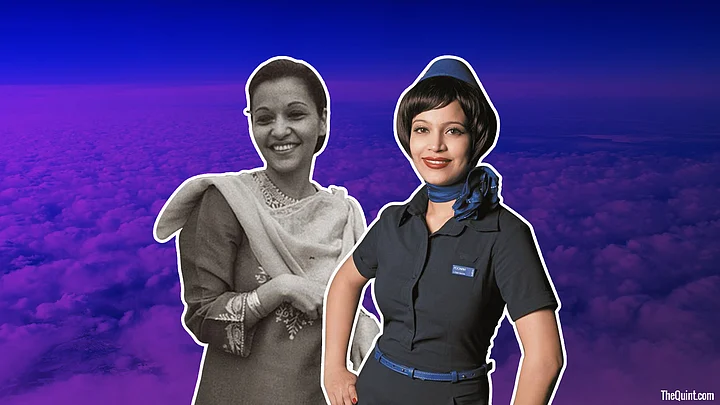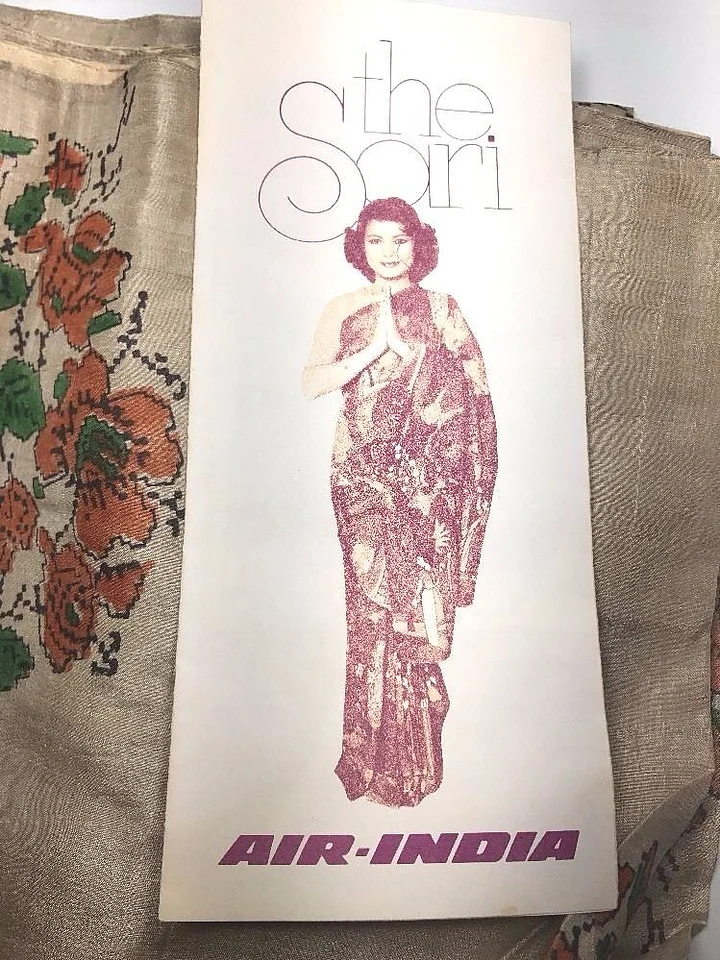It’s 20,000 feet in the sky. As the plane is blanketed in blue from the outside, the aisle is brightened by air hostesses in uniforms that are (wait) as yellow as the colour of mangoes! Have you guessed the airline yet?
Bah. Aside from the not-so-mellow yellow, air hostess uniforms of the three contemporary airlines in the country — Spice Jet, IndiGo and Jet Airways — seem like they have come to form the holy trinity of colours with red, blue, and yellow uniforms. What’s up with that?
But before this bursting palette of colours in our skies, there was an element of subdued grace to our air hostesses’ uniforms. In fact, over the sixties and seventies, the Air India uniforms even came close to weaving a national narrative.
From the formal tailored suits in muted tones in the 1940s to its current, dizzying, basant look, the Air India uniforms have only descended rapidly in matters of style.
Air India’s Many Uniforms
Back when Air India introduced air hostesses in 1946, they wore sharp tailored European dresses, with jaunty angled caps. Most of the hostesses then were either Anglo-Indian or European women who sashayed this Western look with elan.
The AI look remained westernised for almost two decades. The now ubiquitous sari was introduced only in the 1960’s.
Sari: Part of the Exoticisation Project
Saris were adopted when Air India started advertising India as the exotic tourist destination in foreign newspapers. That’s when more Indian girls came to be hired, and the airlines introduced two different types of dress codes. One was a ghagra choli and the other was the sari. By 1970’s, the sari went on to become the permanent dress code in Air India.
As Anu Moulee, who curates Vintage Indian Clothing, writes
When I started the series ‘sari in each decade’, someone mentioned the “air hostess sari” as influencing the way the sari was worn. This was a part of the rebranding of Air India, at the beginning of the 1960s. The drape was probably one of the first attempts to give the sari a “professional” look, and has since remained the gold standard so to speak. The drape structured the sari. Perfectly aligned pleats that fall from the waist, were held in place by a pin. Initially, the sari was pinned at the waist and shoulder, the eventual professional style required pleating and pinning at the shoulder.Anu Moulee, Curator, Vintage Indian Clothing
For almost two decades, through the sixties and seventies, the air hostesses sported rich Kaanjevaram saris, smart churidars and ghaghra cholis. Maureen Wadia, Parmeshwar Godrej and singer Asha Puthli are all proud alumnae of the Air India school from that era.
As Moulee notes, air hostesses generally seemed to have stuck to printed silks with stripes, paisleys, and florals. But there were a few changes reflecting the different decades. For instance, the Rajasthani costume (shown above) came in the 70s. Similarly, with the churidar-kameez – the kurtas in the later 70’s/80’s were longer than the ones in 1971, and also had a cropped jacket.
She also points to how Air India used a lot of old Indian art material and did some sari advertisement, which would have provided context for the garment for the traveller of the time.
In those times, air hostesses had the reputation of being some of the most well-groomed women in the country. Perhaps that was because JRD Tata, as chairman of Air India, laid a keen eye on the nitty-gritty of the airlines, including the grooming of the air hostesses. In 1970, while addressing the cabin crew of the airline, Tata had said: "I feel that our hostess and pursers should have some liberty and freedom to their own make-up and drape their saris, with an individuality of their own. But you must not go too far. We must know where to draw the line between the odd, the ridiculous and the attractive....''.
But in 1978, JRD Tata was sacked unceremoniously by Morarji Desai’s Janata government, and thereafter, the airline, and by extension its air hostesses, were never the same again.
The “Indian Touch” Legacy
Even though the sky-high fame of air hostesses had subsided by then, the glamour in the skies was still very much present.
As Suneeta Kanga, a former air hostess, who served from 1988-1996 and had also flown as a VVIP hostess on the then Prime Minister’s foreign official visits, notes,
We could choose between churidars, pants and saris. When I used to fly, we had different ways of draping the sari. It would be pinned up in the Bharatnatyam sari style at the airports, and as soon as we got to service, the drape would be kept flowing, while in cold countries, we would wear it like a scarf over an overcoat.Suneeta Kanga, former VVIP hostess
Kanga, who is now an international etiquette expert, fondly remembers the times she used to fly back in the day,
During our time, flying was an experience. People would dress up, buy new clothes and new luggage to fly. Air travel hadn’t expanded, or I should say, the world hadn’t shrunk so much then!Suneeta Kanga, former VVIP hostess and international etiquette expert
Contemporary Uniforms: A Riot of Colours
While Air India has retained the sari as part of its uniform, many new-age airlines are keen to portray themselves as more ‘global’ in outlook, by either going for a Western look, or banking on hybrids.
The trend started 2008 onward, and had Kingfisher and Jet Airlines as one of the early adopters.
In 2010, IndiGo went for a ‘Pan-Am’ hot look with a belted tunic, scarf, and a jauntily placed cap. The air hostesses’ asymmetrical bob further accentuated the look. Indigo teamed up with fashion designer Rajesh Pratap Singh for the uniform, and stylist Ambika Pillai for the make-up and hair for the crew.
Meanwhile, Jet Airlines’ yellow jacket and trousers leave fashion experts divided, with some calling it a “vague hybrid” to others “the best uniform out of the current lot”.
Vistara Airlines, whose uniform was unveiled in 2014 and is designed by fashion house Abraham & Thakore, has an Asian aesthetic in aubergine and gold. But the silhouette looks a bit neither here, nor there.
Function over Fashion
While the uniforms are certainly smart, the erstwhile glamour stands substantially subtracted from the skies now.
Fashion historian Toolika Gupta puts it in perspective for us,
Flying now has become too hectic. Air hostesses today have to fly much more than the earlier crop did. Airplane security, too, is a major challenge now. Thus, the emphasis is more on comfort. Also, today, airlines want to make their air hostesses look more approachable. There is a more humanist approach to branding. And that’s a good thing because in the end, being a stewardess is just like a job, and should not be glamorised to an unreal extent.Toolika Gupta, Fashion Historian
After all, one of the primary roles of fashion is to provide grace to function.
(This admission season, The Quint got experts from CollegeDekho.com on board to answer all your college-related queries. Send us your questions at eduqueries@thequint.com)
(At The Quint, we question everything. Play an active role in shaping our journalism by becoming a member today.)


